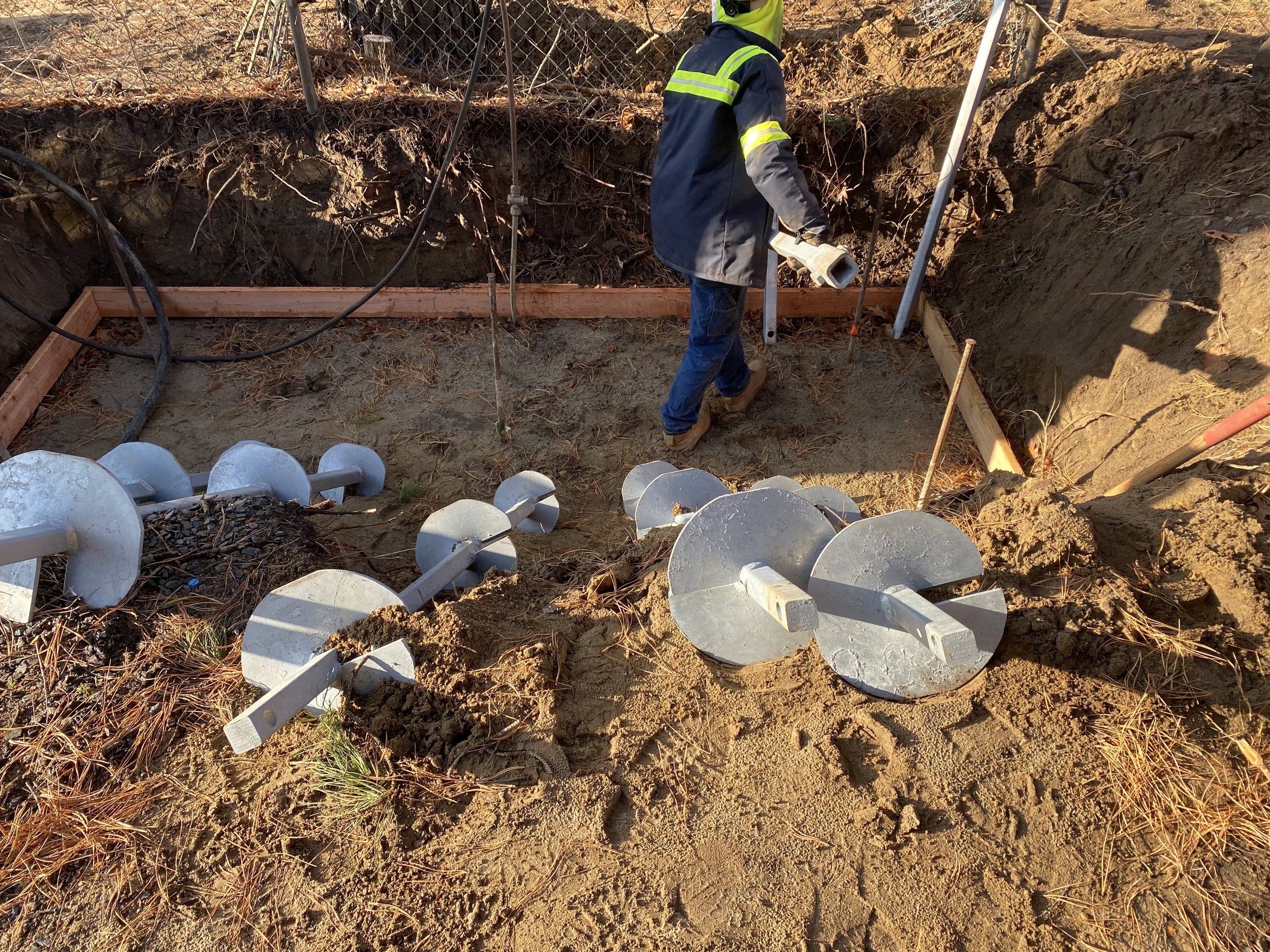Helical Piers for Building and Construction
Construction With Helical Piers
Helical pier construction is a type of deep foundation system. It has many uses of supporting the building or structure, plus it works as a friction pile for lateral and uplifting forces. Helical piers can range in size, based on the structural and civil engineering design. With these foundation design loads, helical piers and piles can support large structures.
Helical piles can be used as a stand alone pile or a group of screw piles driven into the soil, then cut and capped, forming a pile cap. A helical pier is a pile cap that uses a helical or screw pile and concrete poured in the form of a pier. See the Diagram Below.
Let’s take a look at what helical piers can do for your foundation construction project.
Simple Diagram of a Helical Pier
What a helical pier looks like looking down.
Brief History of Helical Piers and Piling in Construction
Helical piles used for piers were invented way back in 1833 by a blind civil engineer named Alexander Mitchell. The first accounts of helical piles were ships moorings in 1836. Since then helical piers have been used for a variety of civil and structural construction projects. They are commonly used in energy foundations such as solar, windfarms and foundations under natural gas pipelines.
There are many uses for marine and coastal structures as the soils are poor for supporting buildings, wharves, and bulkheads. Helical piers can be used as a deadman for sheet and timber piled waterfronts.
Helical piers were even used at the London Olympics in 2012 and Tokyo Olympics in 2020. Case Study of Helical Piers.
What Type of Structure Can Helical Piers Be Used For
The type of construction projects where helical piers are used range from civil projects to telecom towers and large building foundations. Helical piers are used in residential foundations as well. Either in newly constructed homes or when an existing home is settling.
Helical pier foundations are a cost effective alternative to concrete foundations alone. They are installed faster than other types of piling/pier combinations. Plus, the compression testing normally exceeds maximum working load designed by the geotechnical engineers.
Helical Pier Can Be Used For:
Driven helical piling for a pier.
Residential Homes
Condo’s
Parking Garages
High Rise Construction
Solar & Wind Farms
Chemical, Gas & Liquid Pipelines
Marine Construction
Shoring and Support of Excavation
Railroad Projects
And More
Function of Helical Piers
The main function of a helical pier is to support a structure over soils that have low load bearing capacity. A simple method to demonstrate how a helical pile works is to take a nail and push it into the ground. Then take a bolt and push it in. The helix design offers a higher load rating than a smooth steel pile of the similar size.
A screw pier also has the function of friction of up lifting forces. Not only shaft friction, but helix plate friction. Which are good qualities to have for lighter construction projects that have a high wind load. Such as solar farms foundations, wind turbines piers and even billboards.
Using the nail and screw demonstration, drive a nail and a screw into a piece of wood. Now pull them out. The screw, because of its helix design, makes removing the screw more difficult. These are the basic principles of a helix pier system.
Helical Pier Sizes
Helical piles can be used as a stand alone pile or a group of screw piles. Helix piles come in many sizes from as small as three and a half inch diameter, up to 20” outside diameter. The smaller sized screw piles can hold loads of 30-50 tons, while larger diameter helical piles can support loads as high as 300 tons or more.
Helical Piles Being Installed
Large diameter piles (LDPs) are composite piles. Their capacity from skin friction from the pile’s interaction with the soil as well as end-bearing on the helix plates. The helical plates are also a means of advancing the pile during the installation process.
Helical piles have many uses based on size and configuration.
Helical Piers Installation
Helical piles used in pier construction are a driven style pile. But instead of using force, they are screwed in the soil with attachments on heavy equipment like an excavator.
Installing helical piers on construction projects where space is limited is a major advantage of these piles and piers. They can be installed with mini excavators or small drill rigs that can get into tight areas.
Getting the pile driving company set up to drive these piles is quick, as less equipment is needed to be brought on site. Thus reducing the amount of time driving piles and keeping construction projects on schedule.
The benefits of helical pier installation:
Helical Pier Contractors in New Jersey, Delaware, Pennsylvania, Maryland and Virginia
Higher capacities than standard push piers of the same size.
Environmentally sensitive,with no spoils.
No vibration installation
Mitigates accessing narrow or small work areas.
Faster installs
There are a number of helical pile companies in the Mid-Atlantic and Northeast regions of the United States. When choosing a deep foundation company from Washington, DC to New Jersey, look no further than Shore Systems Group, LLC. New Jersey’s helical pier installation experts.




